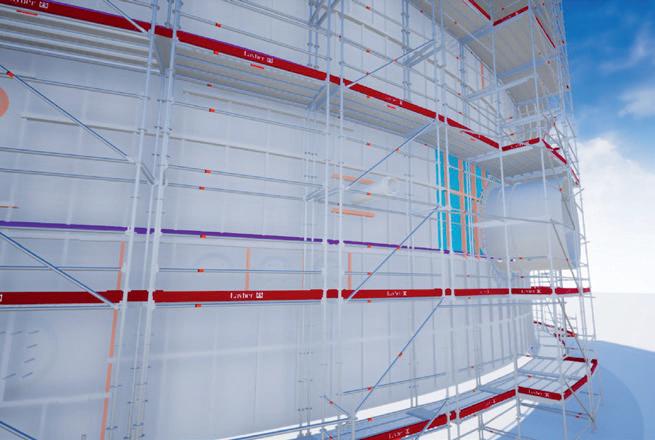
4 minute read
RING OF FIRE
from Scaffmag Issue 11
by ScaffMag
Layher & KAEFER partnership meet complex scaffolding requirements at Hinkley Point C
The safety, versatility and efficiency for which Layher Ltd scaffolding and access systems and KAEFER Ltd expertise are known worldwide are now being dramatically demonstrated during one of the most significant construction projects in the UK for many years.
Advertisement
Hinkley Point C in Somerset is seeing two new nuclear reactors built – the first in this country for over 20 years – to provide 3200 MWe of low-carbon electricity which is sufficient to power six million homes.
Layher’s involvement is via a strategic partnership with KAEFER, who have been commissioned to provide access and specialist coating services during the construction of the Nuclear Island inner containment liners. It is work that has presented significant challenges, as Layher’s UK Managing Director, Sean Pike explains: “Each of the six circular liners includes three steel rings measuring some 48.2 metres in diameter and 17 metres in height,” he says. “The scaffolding has been designed to provide both external and internal access to the faces for coating operations and, therefore, has had to follow the build programme very closely.” He explains that as each structure – comprising a cup, the three rings and a dome – is completed, it is then craned onto the Nuclear Island. “As this process is undertaken, scaffold is being prepared for the second and then subsequent structures to follow on,” says Sean.
The external structures are a particularly impressive blend of design innovation and Layher’s equipment suitability for highly complex installations.
“The scaffolding has to provide access to both vertical and horizontal welds for each ring – a total of some 150 linear metres,” says Jonathan Leyland, UK Design Manager at KAEFER. The external walls of each containment liner also feature a series of circular protrusions which had to be accommodated by the scaffolding design.

ABOVE: Hinkley Point C in Somerset’s new nuclear reactors will be the first in this country for over 20 years providing 3200 MWe of low-carbon electricity which is sufficient to power six million homes. bays and clear access due to no requirement for cross-platform-bracing.
“There is little commonality in the layout of these protrusions on each structure and, also, a wide variation in dimensions – from diameters of 2.7 metres to just 50mm – so it is vital that the scaffold layout is sufficiently adaptable to meet this variation. The Layher equipment has proven to be ideal,” adds Jonathan.
The rosette design of the Layher standards, which allows multiple connections, is ideal for the circular nature of the installations at Hinkley Point. Each makes full use of Layher’s Allround lightweight scaffolding and associated lightweight deck systems to create multiple lifts that encircle each liner. This provides access for painting and coating operations and offers key benefits in terms of wide
It has also led to the innovative development of a specific, adjustable splay deck. This is a one-piece extendable corner unit that removes the need for overlay decking and which, again, reflects the circular nature of the structure.
“The complexity of the scaffold project could only be realised by utilising Layher’s 5D modelling system, SIM (Scaffold Information Modelling) software,” continues Sean Pike. “This interfaces directly with the Building Information Modelling (BIM) technology model used on the project to identify the optimum scaffold layout and build method. Both the complex BIM model and our SIM scaffold model integrate seamlessly, thereby identifying any collisions, clashes and problems long before the scaffold is physically built. This saves time and helps to optimise logistics and labour – and the customer sees what they are getting beforehand.”
This further enables virtual structures to be designed in fine detail and visualised via a VR model on screen or VR headset so that both the layout and movement through the structure can be assessed and modified long before equipment arrives at site. It is estimated that this has reduced the amount of scaffolding that may otherwise have been required for the project by some 15%.

“Hinkley Point C is an important project for KAEFER’s wide range of technical industrial services solutions and a site where we are always looking to apply best practices in construction methodology and digital technology,” explains Trevor Woodward, Director of Business & Strategy for KAEFER in the UK & Ireland.
“We believe in working hard in collaboration with our supply chain partners and customers to provide the most reliable and efficient industrial services. KAEFER chose to use our own 5D scaffolding design expertise, alongside Layher equipment and SIM design capability, for the critical access and containment structures. Access for productivity and efficiency is essential but more importantly we are able to design, model and plan safety critical aspects such as ventilation and rescue. We look forward to continuing our collaboration with Layher on this world-leading project.”









